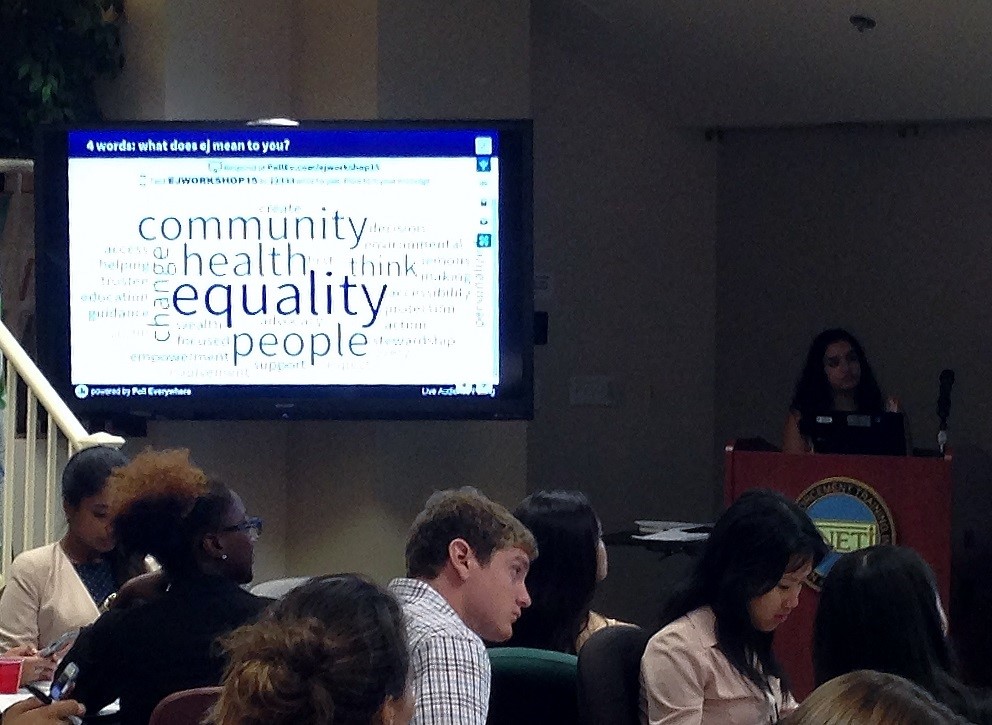Teaching to Lead
By Malavika Sahai and Jonathan Leslie
About the Authors: Malavika Sahai and Jonathan Leslie were summer interns at EPA’s Office of Environmental Justice. Malavika is studying Environmental Policy and Planning and Geography at Virginia Tech. Jonathan is studying Economics and Political Science at the University of Notre Dame. Both will be graduating in Spring 2016.
At 8:30 a.m. on a hot summer day, interns from across EPA’s headquarters filed into a training room to dedicate their morning to a workshop about environmental justice. We found ourselves rushing at the last minute to pull at least a dozen more chairs around tables to accommodate a surge of attendees eager to learn about environmental justice. By 9:00 a.m., the room was packed with more than 70 young people representing a wide range of law schools and undergraduate universities united in their passion for environmental protection.
Last summer, EPA’s Office of Environmental Justice hosted its first annual EPA Intern Environmental Justice Workshop to share information about environmental justice to an up-and-coming generation of environmental leaders. Beyond offering an overview of environmental justice – its history, goals, and the current scope of the movement – OEJ wanted to start a dialogue with young people spending a summer interning at EPA on how to be a part of the workforce that contributes to environmental decision-making.
The workshop opened with a bit of a self-assessment, with attendees offering up personal definitions of “environmental justice.” It was clear that the audience generally understood the context of the environmental justice movement and the importance of protecting underserved communities against environmental hazards. However, over the next four hours, the scope of their knowledge was expanded beyond basic statements about equity to a more personal, more resonant message about how they could help bring about environmental justice.
During the course of the workshop, we learned about environmental justice from a variety of perspectives. Multiple speakers both from within EPA and others working locally to address issues in their own communities, discussed their work to extend environmental protection to underserved communities. They emphasized that environmental justice is neither just an office at EPA nor is it merely a movement that is happening somewhere else. Rather, it is an awareness that must be present in every decision that we make, that full environmental protection cannot be achieved without incorporating the voices and concerns of local residents and advocates during every step of the process. Dr. Jalonne White-Newsome of WeACT noted that as we seek sustainable solutions to new environmental problems resulting from climate change, we must also ascertain that these solutions are equally sustainable for all populations.
The wide-ranging discourse shared an underlying message: that the federal government cannot make accurate and informed decisions for protecting overburdened and underserved communities all by itself. Communities must play an active role in actions to extend environmental protection to their neighborhoods, because each community can be uniquely resilient as a result of facing multiple challenges armed with the specific knowledge of local priorities and needs.
The workshop ended as it started, with the question that began the event: “What does environmental justice mean to you”? As interns texted in answers, their responses were displayed on a screen in real time. It was clear that a single message now resonated for most of the attendees: that community, education, and equity are crucial to informing environmental work.
As the crop of summer interns left the room, we were confident that this up-and-coming generation of environmental leaders who attended the workshop had taken their first steps toward integrating environmental justice into their work: to be mindful to actively listen, to engage all involved individuals, and to seek external input at every level in the decision-making process.
Strong lessons indeed extend environmental justice into their futures, within their own communities, and throughout their chosen careers.

